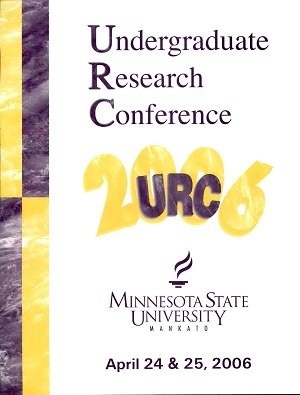Determination of Genetic Diversity of River Otter Populations in Minnesota
Location
CSU 253
Start Date
24-4-2006 10:30 AM
End Date
24-4-2006 12:00 PM
Student's Major
Biological Sciences
Student's College
Science, Engineering and Technology
Mentor's Name
John D. Krentz
Mentor's Department
Biological Sciences
Mentor's College
Science, Engineering and Technology
Description
Natural populations differ genetically from one another primarily because of natural selection and limitations on the exchange of individuals (restricted gene flow). Because a population's ability to adapt to a changing environment depends of genetic variability, a restriction in the exchange of individuals may subsequently result in reduced fitness. Knowledge regarding the genetic make-up of populations is important in the conservation of biological diversity to allow the identification of potential source populations and to maintain variability in small populations. Once widespread, river otter populations in Minnesota were greatly reduced or eliminated due to human activity. Current populations have rebounded and translocations of animals from source populations to areas of local extinction such as the Minnesota River have occurred or are being contemplated. My goal was to quantify (DNA) genetic differences among populations of river otters intimately associated with drainage systems in Minnesota to formulate a phylogenetic map. I hypothesized that populations which are more connected by river systems would probably exchange individuals more frequently and would thus be more similar genetically. Otter tissue was collected from trappers. I used DNA sequence data from prior studies in other states to develop a method for genotyping Minnesota otters. I compared DNA of otters from the Upper Mississippi River and Lower Mississippi River populations, and also compared them to the St. Louis River population (which is not connected to the Mississippi River). The development of our methods for obtaining genotypes and our preliminary data will be presented.
Determination of Genetic Diversity of River Otter Populations in Minnesota
CSU 253
Natural populations differ genetically from one another primarily because of natural selection and limitations on the exchange of individuals (restricted gene flow). Because a population's ability to adapt to a changing environment depends of genetic variability, a restriction in the exchange of individuals may subsequently result in reduced fitness. Knowledge regarding the genetic make-up of populations is important in the conservation of biological diversity to allow the identification of potential source populations and to maintain variability in small populations. Once widespread, river otter populations in Minnesota were greatly reduced or eliminated due to human activity. Current populations have rebounded and translocations of animals from source populations to areas of local extinction such as the Minnesota River have occurred or are being contemplated. My goal was to quantify (DNA) genetic differences among populations of river otters intimately associated with drainage systems in Minnesota to formulate a phylogenetic map. I hypothesized that populations which are more connected by river systems would probably exchange individuals more frequently and would thus be more similar genetically. Otter tissue was collected from trappers. I used DNA sequence data from prior studies in other states to develop a method for genotyping Minnesota otters. I compared DNA of otters from the Upper Mississippi River and Lower Mississippi River populations, and also compared them to the St. Louis River population (which is not connected to the Mississippi River). The development of our methods for obtaining genotypes and our preliminary data will be presented.
Recommended Citation
McCalla, Sunnie. "Determination of Genetic Diversity of River Otter Populations in Minnesota." Undergraduate Research Symposium, Mankato, MN, April 24, 2006.
https://cornerstone.lib.mnsu.edu/urs/2006/oral-session-D/5



